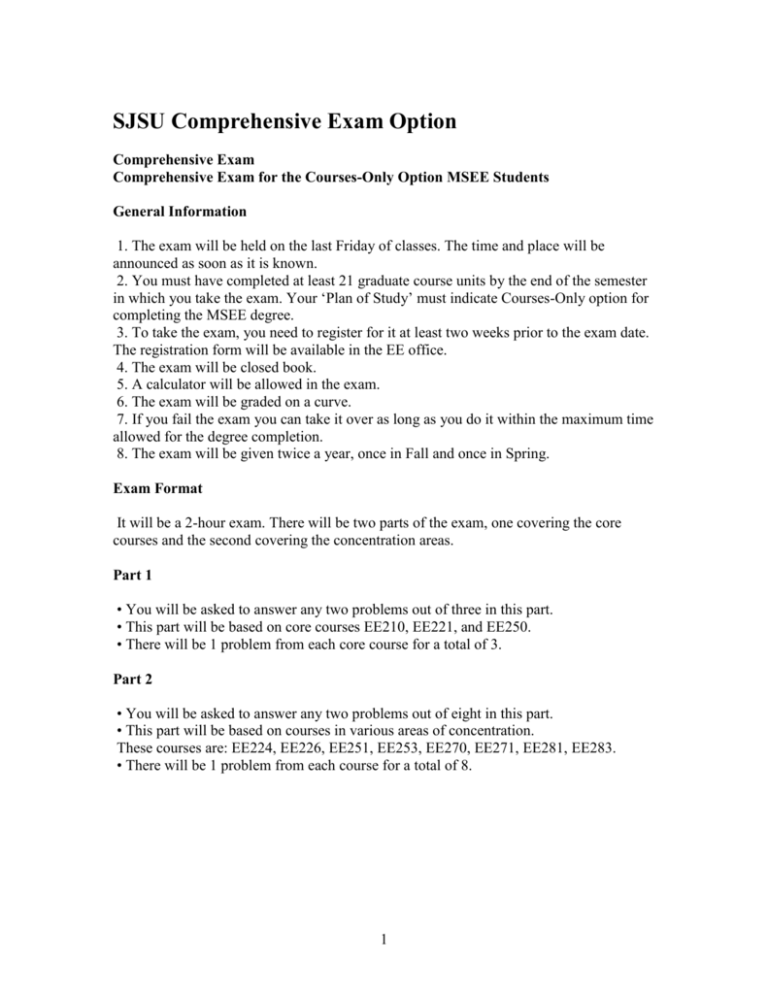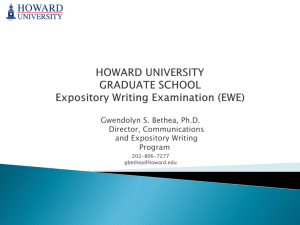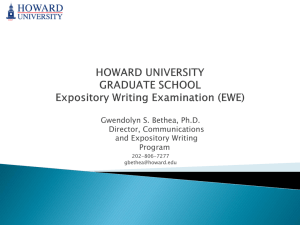Comprehensive Exam Requirements from SJSU, SDSU, and CSULB
advertisement

SJSU Comprehensive Exam Option Comprehensive Exam Comprehensive Exam for the Courses-Only Option MSEE Students General Information 1. The exam will be held on the last Friday of classes. The time and place will be announced as soon as it is known. 2. You must have completed at least 21 graduate course units by the end of the semester in which you take the exam. Your ‘Plan of Study’ must indicate Courses-Only option for completing the MSEE degree. 3. To take the exam, you need to register for it at least two weeks prior to the exam date. The registration form will be available in the EE office. 4. The exam will be closed book. 5. A calculator will be allowed in the exam. 6. The exam will be graded on a curve. 7. If you fail the exam you can take it over as long as you do it within the maximum time allowed for the degree completion. 8. The exam will be given twice a year, once in Fall and once in Spring. Exam Format It will be a 2-hour exam. There will be two parts of the exam, one covering the core courses and the second covering the concentration areas. Part 1 • You will be asked to answer any two problems out of three in this part. • This part will be based on core courses EE210, EE221, and EE250. • There will be 1 problem from each core course for a total of 3. Part 2 • You will be asked to answer any two problems out of eight in this part. • This part will be based on courses in various areas of concentration. These courses are: EE224, EE226, EE251, EE253, EE270, EE271, EE281, EE283. • There will be 1 problem from each course for a total of 8. 1 SDSU Comprehensive Exam Option Plan B: Non - Thesis Option Student selecting Plan B must complete 30 units of course work (10 courses) and must pass a written comprehensive examination. EE 707 cannot be used as one of the course required for graduation. The written comprehensive examination tests the students understanding and mastery of fundamental principles and their ability to apply them to engineering problems. Members of the ECE faculty will grade the comprehensive examination for technical correctness, completeness, and clarity of expression. After two unsuccessful attempts the student may not take the examination again without written permissions from the department chair. The chair, at this time, may require the student to successfully complete certain additional courses before taking the comprehensive examination a third and final time. MS Comprehensive Examination (Plan B) A 4-hour long MSEE Comprehensive Examination will consist of 35-40 questions from each of our department’s areas of emphasis-Communications, Computers, Electronics/Networks, Physical Electronics, and Power/Control Systems. Each examinee will be required to answer seven questions (of their own choosing) from three different areas including a general EE short essay question. The short essay question serves to check a student’s writing proficiency, a statutory requirement for the MS degree. The examination questions will test the student’s understanding of fundamental principles and his /her ability to apply these principles to engineering problems. These questions also test the student’s ability to communicate effectively using mathematical equations, graphs, and correctly constructed prose. The examination questions will be aimed approximately at the early graduate level of sophistication rather than at the upper most level. The intent of the comprehensive exam questions is to ascertain the students’ ability to recall, integrate, and apply basic principles taught during their graduate studies. The Reserve Book Room in Love Library has sample questions to guide your preparation for this exam. The MS Comprehensive Examination is offered once each semester, usually at the 11th or 12th week. The date, time, and place will be announced near the middle of the semester. In order to take the examination, a student must register in the ECE Department Office at least two weeks before to the exam date. A student may not register for this examination until being advanced to candidacy. The examination will be read by the faculty and an average of 70% or higher is required to pass. The criteria for grading will include technical correctness and completeness, as well as conciseness and clarity of expression. Exam papers will not be returned but may be reviewed with a faculty member if desired. 2 Upon failure, a student may take the comprehensive examination a second time. After two unsuccessful attempts, the student may not take the examination a third time without specific, written permission from the department chair. The chair or graduate advisor, at this time, will likely require the MSEE candidate to successfully complete certain additional courses before taking the Comprehensive Examination one final time. Requirements for MSEE - Subject Area for Comprehensive Exam Subject Areas and topics for the Comprehensive exam The topics for the preparation for the comprehensive exam are given below. I. Control Systems Time and frequency domain performance of feedback control systems, Root Locus Method, Bode and Nyquist plots, Compensator design using root-locus and frequency response techniques, digital controller design, state space models, solution of state equation, controllability, stability, observability, pole- placement and observer design Recommended SDSU Courses: EE 520, EE 600 Suggested Texts: 1. Dorf and Bishop: Modern control Systems, Ninth Edition, Prentice Hall, 2001 2. Chen: Linear State Space Design, Addison-Wesley II. Physical Electronics The comprehensive examination in the area of physical electronics centers around the basic topics in physical electronics, including electromagnetic theory, optics and lasers, and semiconductor physics. These include the following. Electromagnetic Field Theory: electrostatic, magnetostatic, and time-varying electromagnetic fields; energy, forces, torque, and momentum in fields; fields in materials and at boundaries; electromagnetic waves and propagation; transmission lines, microwaves, and antennas. Optics: Ray, beam, wave and Fourier optics; optical fibers, resonators, and couplers; photon interaction with matter; laser amplifiers and oscillators; optical sources, detectors, couplers, and switches; line-of-sight and fiber communication. Semiconductor Physics: Band theory, equilibrium carrier concentrations, excess carriers in semiconductors, carrier transport, carrier generation and recombination, semiconductor homojunctions and heterojunctions, field-effect and bipolar transistors, power, optical, and microwave devices. Recommended SDSU Courses: While many courses in the physical electronics area are helpful as a refresher in preparing for the comprehensive examination, some that directly help the preparation are: 3 EE 534 Solid State Devices EE 540 Microwave Devices and Systems EE 541 Electro-optics EE 546 Optical Fiber Communication Systems Suggested Texts 1. D. Pozar, Microwave Engineering, John-Wiley, N.Y, 1998 2. A. Yariv, Optical Electronics (Holt, Rinehart, and Winston, 1991). 3. B. Streetman and S. Banerjee, Solid State Electronic Devices, 5th ed (Prentice Hall, Upper Saddle river, N. J., 2000). 4. W. H. Hayt Jr., and J. A. Buck, “ Engineering Electromagnetics”, McGraw-Hill, NY, 2001 III. Electronics/Networks Models of Integrated Circuit Active Devices, Single and Two Transistor Amplifiers, Transistor Current Sources & Active Loads, Bipolar, MOS, and BiCMOS IC Technology, Output Stages, Operational Amplifiers, Frequency Response of ICs, Feedback, Frequency Response and Stability of Feedback Amps, Nonlinear Analog Circuits and Noise in ICs, Design and analysis of hybrid analog/digital electronic subsystems incorporated into modern instrument design, operational amplifier based circuit design and analog-to-digital and digital-to-analog conversion processes, Voltage to current converters, Sample and hold circuits, Voltage to time duration converters (6 class hours) (single slope, dual slope, quad slope), Oversampled analog to digital converts (3 class hours), Voltage to frequency converters, Digital to analog converters, Successive approximation and flash converters, Switched capacitor converters, and ECL, CMOS and Bi-CMOS and high speed logic. Areas covered in instrumentation (EE539) are as follows: basic op-amp fundamentals, inverting, non-inverting, differential, resistive feedback applications such as V to I converters, I to V converters, sensor interface, 1st and 2nd order active filters, static opamp limits, DC errors due to input offsets, dynamic op amp limits, gain bandwidth limit, slew rate limit, loop gain reduction, broadband noise and reduction techniques, and feedback stability techniques. Recommended SDSU Courses: EE530, 539, and 570 Suggested Texts: 1. Digital Integrated Circuits, McGraw-Hill, 1999 2. Digital Electronics: A Practical Approach, Prentice Hall, 1999 3. Franco, Design with Operational Amplifiers and Analog Integrated Circuits, McGraw Hill, 1988 4. P.R. Gray, P.J. Hurst, S.H. Lewis, and R.G. Meyer, Analysis & Design of Analog ICs, 4 4th Edition, Wiley & Sons, 2001. 5. A.S. Sedra and K.C. Smith, Microelectronic Circuits, 5th Edition, Saunders, 2004. IV. Power Systems Transmission Lines, Admittance and Impedance Models of Network Calculations, Power –Flow Solutions, Economic Dispatch, Voltage Transients and stability, Symmetrical components, Unsymmetrical Faults, Protection of Power Systems, Transient Power Stability, Power System Controls, Control rectifiers, AC voltage Controllers, DC choppers, Pulse-Width Modulated Inverters, Resonant Pulse converters. Recommended SDSU courses: EE 580, EE 581, EE 582, EE 583, EE 680 Suggested Texts: 1. J. J. Grainger and W. D. Stevenson, “ Power System Analysis”, McGraw-Hill Publishing Co. 2. Arrillaga, J., Arnold C.P., and Harker B.J., “ Computer Modeling of Electrical Power Systems, John –Wiley and Sons 3. Heydt G. T., Computer Analysis Methods for Power Systems, Macmillan Publishing Co., NY 4. Mohan, Undeland, Robbins, Power Electronics, Third Ed., Wiley V. Communication and Signal Processing Classical DSP, multi-rate signal processing, statistical signal processing, optimum receiver design, M-ARY communications, performance of digital communication system in the presence of noise. Recommended SDSU Courses: EE 556, EE 650 Suggested Texts: 1. Sanjit Mitra, “ Digital Signal Processing: A Computer Based Approach”, McGraw Hill Publishing Co. 2. Bernard Sklar, “ Digital Communications: Fundamentals and Applications”, Prentice Hall VI. Computer Engineering The examination questions in Computer Engineering are of two types. Some are questions posed from a graduate perspective that test basic concepts covered in the undergraduate Computer Engineering curriculum at most universities. Other questions derive from concepts covered in graduate-level Computer Engineering courses such as CompE560, 565, and 572 and EE672, 675, 678, 679, and 706. Topic areas covered by the exam include: 5 1. Combinational and Sequential Circuit Design 2. VHDL based Computer Aided Design 3. VLSI Circuit and System Design 4. FPGA and other Programmable Devices 5. Computer Architecture 6. Embedded Systems 7. C Family Languages 8. Object-Oriented Programming 9. Data Structures 10. Algorithms 11. Operating Systems 12. Computer Networks Suggested Texts: 1.Wakerly, John, “Digital Design: Principles and Practice”, 3rd edition, 2001, Prentice Hall 2. Patterson and Hennesy, “Computer Architecture: A Quantitative Approach”, 3rd edition, 2003, Morgan Kaufmann 3. Deitel and Deitel, “C How to Program”, 4th edition, Prentice –Hall, 2004 4. C. H. Roth, Fundamentals of Logic Design, 5th ed., Thomson Brooks/Cole (2004) 5. N. H. E. Weste and K. Eshraghian, Principles of CMOS Design, 2nd ed., AddisonWesley (1993) 6. P. Pirsch, Architectures for Digital Signal Processing, Wiley, 1998 7. Douglas J. Smith, “HDL Chip Design: A Practical Guide for Designing, Synthesizing and Simulating ASICs and FPGAs using VHDL or Verilog”, Doone Publications, 1996. 8. Barry B. Brey, “The Intel Microprocessors: 8086/8088, 80186, 80286, 80386, 80486, Pentium, Pentium Pro, Pentium II, Pentium III, Pentium 4”, Sixth Edition, 2003, Prentice-Hall 9. Rao, “ Multimedia Communication Systems”, Pearson 10. Rao, “ Techniques and Standards for Image Video and Audio Coding,”Pearson 11. William Stallings, “Computer Networks”, 6th Edition, Prentice Hall 12. Nyhoff, Larry, C++: An Introduction to Data Structures”, 1999, Prentice Hall CSULB Comprehensive Exam Option Final Comprehensive Examination Each student must take the Oral Examination whether in the thesis or project option. Of course, one should have advanced to candidacy much much earlier and completed all the course work (or will be completing by the end of that semester) in order to be permitted to take the comprehensive exam. To be eligible for the Final Comprehensive Exam, the student's approved 31 unit graduate program (all courses either completed or currently in progress) must exhibit a program GPA of at least 3.0 and the student's overall GPA (including all courses taken after admission to the graduate program such as technical writing) must also be at least 3.0. The student must be enrolled in one course 6 or GS 700 during the semester in which the student takes the Comprehensive Examination. The Comprehensive Exam for the thesis option covers the thesis and supporting theory. A grade will be given to each student by the Committee during the Thesis Defense in which the student must defend the thesis and exhibit knowledge of supporting material. That grade will then replace the grade of RP (report in progress), given to the student each semester during which EE 698 were taken. Similarly the Comprehensive Exam for the project option covers the project work including the project report and the presentation of the project work to the Final Oral Exam Committee with the Project Advisor as Chair, which determines if the student has passed the exam and if so assigns the grade for the EE 697 units enrolled by the student. The student prepares the presentation for about 45 minutes to 1 hour. It may use overhead transparencies or power point slides. The rest of the time may be taken up by questions. The graduate advisor will assign the other members of the committee sometime about two weeks before the finals week. The student submits copies of the presentation to all the members in advance so that they can peruse. Also he/she submits one copy for file with the Graduate Advisor. The exam normally takes two hours and is usually oral. Where the student is clearly ill prepared or clearly well prepared, the exam may be terminated early. The examination must be tape-recorded. The student should bring a blank 120 or 90-minute cassette tape to the exam. When a student passes, that tape and any previously recorded tapes of failed exams will be cleared. Until a student passes the exam, the tapes of all unsuccessful exams will be held for 7 years. In case a student fails the Comprehensive Examination, he or she may petition to retake the examination no sooner than the following semester. The procedures for the non-thesis option Comprehensive Examination are as follows: 1. Each student who is eligible for the exam and wishes to schedule the Exam must provide the EE graduate advisor with the student's final exam schedule. 2. Each faculty member will provide the graduate advisor with a final exam schedule and identify ten or more final exam periods spread over three days during which the faculty member will be available for the Exam. Failure to respond will imply that all unscheduled final exam periods are available. 3. Each faculty member will be asked to identify areas of competence. 4. Graduate advisor will attempt to: a. Schedule faculty based on areas of expertise. b. Complete Exam Committee assignments by about two weeks before the finals week 5. When a student's Exam is scheduled it becomes the responsibility of each student to: Ensure that each faculty member is aware of the time, date and room number. Ensure that a tape recorder is available with a blank tape (120 or 90 minutes duration) Provide each faculty member with a copy of the student's Advancement to Candidacy form (containing the student's program and grades) or any other information required. Remind the Exam Chair to fill out the Report of the Comprehensive Exam and remind 7 the Chair to forward that report to the Graduate Advisor. 6. It is the responsibility of the Exam Chair to: a. Fill out the "Report of the Comprehensive Exam", b. Obtain signatures of the Exam Committee, c. Assign a letter grade if the Exam covers the student's thesis, d. Forward the Report immediately to the Graduate Coordinator. Failure to do so will delay the student's graduation. 7. It is the responsibility of the Exam Committee members to: a. Meet at the assigned time b. Arrange an alternate meeting with the student if an emergency makes it impossible to meet at the assigned time c. Sign the Report form d. Agree on a grade for a thesis or project student. 8. The Exam committee of the comprehensive exam for the project option has the following options: a. Pass the student and assign a letter grade. b. Fail the student, indicating whether or not an additional trial may be allowed (conditions may be imposed for re-examination). c. Conditionally pass the student, imposing conditions that must be met to complete requirements. Usually, no further comprehensive oral exam would be required. The Graduate Advisor will not forward the Exam results until conditions are met. 8








